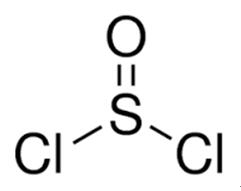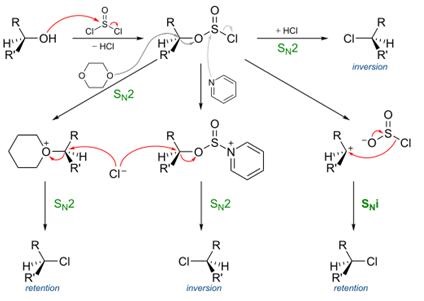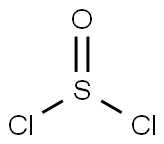Thionyl chloride- a Sulfinyl Halide
Thionyl chloride is an inorganic compound with the chemical formula SOCl2. Thionyl chloride is a sulfinyl halide in which both of the halide atoms are chorines. It is a sulfinyl halide and a chlorine molecular entity. Thionyl chloride appears as a colorless to yellow fuming liquid with a suffocating pungent odor. Boiling point 79 °C. A lachrymator. Highly corrosive and toxic. Long-term inhalation of low concentrations or short-term inhalation of high concentrations has adverse health effects.
SOCl2 adopts a trigonal pyramidal molecular geometry with Cs molecular symmetry. This geometry is attributed to the effects of the lone pair on the central sulfur (IV) center. In the solid state SOCl2 forms monoclinic crystals with the space group P21/c [1]. Thionyl chloride has a long shelf life, however "aged" samples develop a yellow hue, possibly due to the formation of disulfur dichloride. It slowly decomposes to S2Cl2, SO2 and Cl2 at just above the boiling point. Thionyl chloride is susceptible to photolysis, which primarily proceeds via a radical mechanism. Samples showing signs of ageing can be purified by distillation under reduced pressure, to give a colourless liquid.
Thionyl chloride is sometimes confused with sulfuryl chloride, SO2Cl2, but the properties of these compounds differ significantly. Sulfuryl chloride is a source of chlorine whereas thionyl chloride is a source of chloride ions.

In 1849, the French chemists Jean-François Persoz and Bloch, and the German chemist Peter Kremers (1827-?), independently first synthesized thionyl chloride by reacting phosphorus pentachloride with sulfur dioxide. However, their products were impure: both Persoz and Kremers claimed that thionyl chloride contained phosphorus, and Kremers recorded its boiling point as 100 °C (instead of 74.6 °C). In 1857, the German-Italian chemist Hugo Schiff subjected crude thionyl chloride to repeated fractional distillations and obtained a liquid which boiled at 82 °C and which he called Thionylchlorid. In 1859, the German chemist Georg Ludwig Carius noted that thionyl chloride could be used to make acid anhydrides and acyl chlorides from carboxylic acids and to make alkyl chlorides from alcohols [2].
The major industrial synthesis involves the reaction of sulfur trioxide and sulfur dichloride:
SO3 + SCl2 → SOCl2 + SO2
Other methods include syntheses from phosphorus pentachloride, chlorine and sulfur dichloride, or phosgene:
SO2 + PCl5 → SOCl2 + POCl3
SO2 + Cl2 + SCl2 → 2 SOCl2
SO3 + Cl2 + 2 SCl2 → 3 SOCl2
SO2 + COCl2 → SOCl2 + CO2
The first of the above four reactions also affords phosphorus oxychloride (phosphoryl chloride), which resembles thionyl chloride in many of its reactions.
Thionyl chloride is primarily used as a chlorinating reagent, with approximately 45,000 tonnes (50,000 short tons) per year being produced during the early 1990s. It is toxic, reacts with water, and is also listed under the Chemical Weapons Convention as it may be used for the production of chemical weapons.
Thionyl chloride can affect you when breathed in. It is a corrosive chemical and contact can severely irritate and burn the skin and eyes with possible eye damage. Exposure to thionyl chloride can irritate the lungs causing coughing and/or shortness of breath. Higher exposures can cause a build-up of fluid in the lungs (pulmonary edema), a medical emergency, with severe shortness of breath. Thionyl chloride is a reactive chemical and an explosion hazard.
Thionyl chloride is mainly used in the industrial production of organochlorine compounds, which are often intermediates in pharmaceuticals and agrichemicals. It usually is preferred over other reagents, such as phosphorus pentachloride, as its by-products (HCl and SO2) are gaseous, which simplifies purification of the product.
Many of the products of thionyl chloride are themselves highly reactive and as such it is involved in a wide range of reactions.
With oxygen species
Thionyl chloride reacts exothermically with water to form sulfur dioxide and hydrochloric acid:
SOCl2 + H2O → 2 HCl + SO2
By a similar process it also reacts with alcohols to form alkyl chlorides. If the alcohol is chiral the reaction generally proceeds via an SNi mechanism with retention of stereochemistry; however, depending on the exact conditions employed, stereo-inversion can also be achieved.

With nitrogen species
With primary amines, thionyl chloride gives sulfinylamine derivatives (RNSO), one example being N-sulfinylaniline. Thionyl chloride reacts with primary formamides to form isocyanides and with secondary formamides to give chloroiminium ions; as such a reaction with dimethylformamide will form the Vilsmeier reagent [3]. By analogous process primary amides will react with thionyl chloride to form imidoyl chlorides, with secondary amides also giving chloroiminium ions. These species are highly reactive and can be used to catalyse the conversion of carboxylic acids to acyl chlorides, they are also exploited in the Bischler–Napieralski reaction as a means of forming isoquinolines. Primary amides will continue on to form nitriles if heated (Von Braun amide degradation). Thionyl chloride has also been used to promote the Beckmann rearrangement of oximes.
With sulfur species
Thionyl chloride will transform sulfinic acids into sulfinyl chlorides. Sulfonic acids react with thionyl chloride to produce sulfonyl chlorides [4]. Sulfonyl chlorides have also been prepared from the direct reaction of the corresponding diazonium salt with thionyl chloride. Thionyl chloride can be used in variations of the Pummerer rearrangement [5].
With phosphorus species
Thionyl chloride converts phosphonic acids and phosphonates into phosphoryl chlorides. It is for this type of reaction that thionyl chloride is listed as a Schedule 3 compound, as it can be used in the "di-di" method of producing G-series nerve agents. For example, thionyl chloride converts dimethyl methylphosphonate into methylphosphonic acid dichloride, which can be used in the production of sarin and soman.
With metals
As SOCl2 reacts with water it can be used to dehydrate various metal chloride hydrates, such MgCl2•6H2O, AlCl3•6H2O, and FeCl3•6H2O. This conversion involves treatment with refluxing thionyl chloride and follows the following general equation:
MCln•xH2O + x SOCl2 → MCln + x SO2 + 2x HCl
Other reactions
Thionyl chloride can engage in a range of different electrophilic addition reactions. It adds to alkenes in the presence of AlCl3 to form an aluminium complex which can be hydrolysed to form a sulfinic acid. Both aryl sulfinyl chlorides and diaryl sulfoxides can be prepared from arenes through reaction with thionyl chloride in triflic acid or the presence of catalysts such as BiCl3, Bi(OTf)3, LiClO4 or NaClO4. In the laboratory, a reaction between thionyl chloride and an excess of anhydrous alcohol can be used to produce anhydrous alcoholic solutions of HCl.
Thionyl chloride undergoes halogen exchange reactions to give compounds such as thionyl bromide and thionyl fluoride
3 SOCl2 + 2 SbF3 → 3 SOF2 + 2 SbCl3
SOCl2 + 2 HBr → SOBr2 + 2 HCl
Thionyl chloride is a component of lithium–thionyl chloride batteries, where it acts as the positive electrode (cathode) with lithium forming the negative electrode (anode); the electrolyte is typically lithium tetrachloroaluminate. The overall discharge reaction is as follows:
4 Li + 2 SOCl2 → 4 LiCl + S + SO2
These non-rechargeable batteries have many advantages over other forms of lithium battery such as a high energy density, a wide operational temperature range and long storage and operational lifespans. However, their high cost and safety concerns have limited their use. The contents of the batteries are highly toxic and require special disposal procedures; additionally, they may explode if shorted.
References
[1] Mootz, D.; Merschenz-Quack, A. (15 May 1988). "Structures of thionyl halides: SOCl2 and SOBr2". Acta Crystallographica Section C. 44 (5): 926–927. doi:10.1107/S010827018800085X.
[2] https://en.wikipedia.org/wiki/Thionyl_chloride
[3] Arrieta, A.; Aizpurua, J. M.; Palomo, C. (1984). "N,N-Dimethylchlorosulfitemethaniminium chloride (SOCl2-DMF) a versatile dehydrating reagent". Tetrahedron Letters. 25 (31): 3365–3368. doi:10.1016/S0040-4039(01)81386-1.
[4] Weinreb, S. M.; Chase, C. E.; Wipf, P.; Venkatraman, S. (2004). "2-Trimethylsilylethanesulfonyl chloride (SES-Cl)". Organic Syntheses.; Collective Volume, 10, p. 707
[5] Hogan, P. J.; Cox, B. G. (2009). "Aqueous Process Chemistry: The Preparation of Aryl Sulfonyl Chlorides". Organic Process Research & Development. 13 (5): 875–879. doi:10.1021/op9000862.
You may like
See also
Lastest Price from Thionyl chloride manufacturers

US $1.00/KG2025-04-21
- CAS:
- 7719-09-7
- Min. Order:
- 1KG
- Purity:
- 99%
- Supply Ability:
- 10 mt

US $5.00/kg2024-06-18
- CAS:
- 7719-09-7
- Min. Order:
- 20kg
- Purity:
- 99%
- Supply Ability:
- 500 ton / per month


